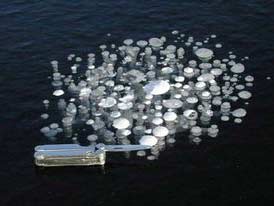Siberian lakes, a source of huge methane emissions
The lakes in Siberia emit more methane in the air than expected.
According to US researchers in Nature , this phenomenon will increase, forming a vicious cycle: rising temperatures increase the areas of Siberia lakes, release more methane gas, increase the hot climate gradually.
 Methane gas is trapped in a frozen lake in Siberia (Photo: yubanet.com) Methane is a powerful greenhouse gas. Born from the destruction of organic matter, this gas is trapped in the Siberian permafrost of the Pleistocene.
Methane gas is trapped in a frozen lake in Siberia (Photo: yubanet.com) Methane is a powerful greenhouse gas. Born from the destruction of organic matter, this gas is trapped in the Siberian permafrost of the Pleistocene.
Dr. Katey Walter and colleagues at the University of Alaska studied the formation of methane bubbles on the surface of lakes in Northern Siberia in the Cherskii region. In the winter, they traveled on two frozen lakes to collect methane bubbles trapped under the ice. In some places, boiling has melted the surface. In the summer, researchers placed methane traps under the lake to measure emissions. They went through about 10 other lakes to check whether the two lakes above were an exception.
The researchers concluded that lakes in northern Siberia emitted 3.8 million tons of methane per year, 10 to 63% higher than previously estimated. The surface of the lakes has expanded by 14.5% from 1974 to 2000 in Northern Siberia, increasing the methane emissions in this area by 58%.
VN
- Hydroelectricity discharges one billion tons of CO2 into the atmosphere every year
- Scientists have successfully studied rice varieties with low methane emissions
- Collect emissions from cows
- The amount of greenhouse gas emissions reaches a record level
- Measure cow's emissions to combat climate change
- The Arctic Ocean emits greenhouse gases
- A huge methane gas leak in the Arctic was discovered
- Graphene films can turn methane gas into an energy source
- Underwater power plant in Rwanda
- Study the phenomenon of
- New computer model about Moon Titan
- Discovering huge lakes in the Antarctic ice
 Is the magnetic North Pole shift dangerous to humanity?
Is the magnetic North Pole shift dangerous to humanity? Washington legalizes the recycling of human bodies into fertilizer
Washington legalizes the recycling of human bodies into fertilizer Lightning stone - the mysterious guest
Lightning stone - the mysterious guest Stunned by the mysterious sunset, strange appearance
Stunned by the mysterious sunset, strange appearance